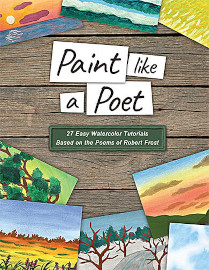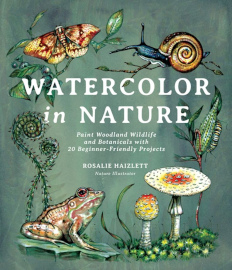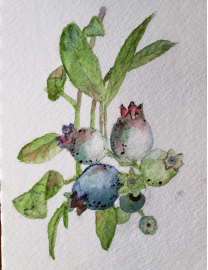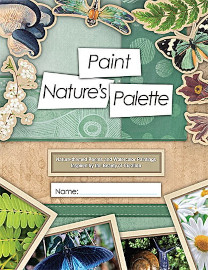Heart of Dakota has combined poetry with instruction in watercolor painting by providing courses for two different levels as standalone courses or as part of their complete programs. Paint Like a Poet was created for use with Hearts for Him Through Time: Creation to Christ for ages 9 to 11, and Paint Nature’s Palette is part of the package for Hearts for Him Through Time: Missions to Modern Marvels for ages 12 to 14. Each Heart of Dakota program can be used beyond the specified ages, and that applies to the poetry and painting courses as well.
The guides for the Heart of Dakota courses provide specific lesson plans, but you can figure out how to use these poetry and painting courses without the guides for the complete courses. However, using them on their own leaves it to parents to determine how much teaching to do regarding the poems.
The spiral-bound books for the painting and poetry courses are beautifully designed and printed on heavy paper in full color. The instruction for watercolor painting is included within Paint Like a Poet. For Paint Nature’s Palette, painting instruction is provided through a separate book—Watercolor in Nature. Both courses recommend high-quality watercolors in either cakes or tubes, along with an assortment of brushes and the appropriate size watercolor paper, and Heart of Dakota sells a kit for each course with exactly the supplies you need.
Paint Like a Poet
 Paint Like a Poet features 27 poems by Robert Frost with a watercolor project for each poem that reflects the poem’s theme. For instance, the project for the poem “Fireflies in the Garden” is a nighttime scene with fireflies that are represented by white and yellow dots rather than detailed figures. A stanza or section of each poem is printed in a different color to indicate the portion students should use for copywork. (Copywork is to be written in a separate notebook.)
Paint Like a Poet features 27 poems by Robert Frost with a watercolor project for each poem that reflects the poem’s theme. For instance, the project for the poem “Fireflies in the Garden” is a nighttime scene with fireflies that are represented by white and yellow dots rather than detailed figures. A stanza or section of each poem is printed in a different color to indicate the portion students should use for copywork. (Copywork is to be written in a separate notebook.)
The poems are on the left pages and step-by-step watercolor tutorials are on the facing page. The tutorials are illustrated with five or six images, each with easy-to-follow directions. Instructions include details such as when to paint on pre-wetted paper or dry, when to use a paper towel to blot extra moisture, how to mix colors to achieve a particular shade, and tips for painting tree trunks to show depth of field.
The projects are designed to be manageable for beginners, and they gradually teach several skills and techniques to achieve different effects. Most of the projects are nature scenes or elements of nature such as clouds, a path through the woods, windblown flowers in a field, and hills with clouds. Each project should not take much time to paint, but all except two projects tell students to let the background dry before continuing. That means most of them will be completed in two sessions.
The supply set for this course includes a boxed set of 24 watercolors in tubes, a palette, a 25-sheet pad of watercolor paper (5.9” x 9.3”), a set of eight brushes, and a bag for the brushes. In addition to the boxed set, Heart of Dakota’s supply kit includes a 30-sheet watercolor pad (9” x 12”), a sponge, and a large brush (with bristles almost an inch wide). You need to provide a few supplies of your own, such as paper towels, toothpicks, and a water dropper. Paint Like a Poet recommends using the larger size watercolor paper, but students might like to experiment with the smaller size for some projects.
Paint Nature’s Palette
Paint Nature’s Palette: Nature-themed Poems and Watercolor Paintings Inspired by the Beauty of Creation presents 17 poems by authors such as Thomas Hardy, Emily Dickinson, Christina Rossetti, and Aesop. Paint Nature’s Palette presents the poem on the left page. To the right is a small photo related to the poem next to five lines where students can write a journal entry. Most of the space on the right-hand pages is where students are to mount their completed projects, which relate to the themes of the poems.
The painting supplies for this course differ from those for Paint Like a Poet. They include a set of 8 watercolor cakes, a tube of cadmium red light paint, a palette, three paint brushes, a drawing pencil, a Micron® Fineliner pen, a drawing pencil, a Magic Rub® eraser, and 25 watercolor sheets (5” by 7”). This size watercolor sheet will fit on the pages of the book.
 Watercolor in Nature, the 168-page book by Rosalie Haizlett, provides very detailed lessons for 20 projects, three more than in Paint Nature’s Palette. (Students can use the other three lessons if they want to.) The book begins with some basic instruction students should read about the supplies. Then it explains how to work with the watercolor cakes in several ways, such as wet-on-wet versus wet-on-dry painting, paint blending, and creating highlights. It also shows how to use the Fineliner pen to create lines and textures, since it will be used in more than half of the projects.
Watercolor in Nature, the 168-page book by Rosalie Haizlett, provides very detailed lessons for 20 projects, three more than in Paint Nature’s Palette. (Students can use the other three lessons if they want to.) The book begins with some basic instruction students should read about the supplies. Then it explains how to work with the watercolor cakes in several ways, such as wet-on-wet versus wet-on-dry painting, paint blending, and creating highlights. It also shows how to use the Fineliner pen to create lines and textures, since it will be used in more than half of the projects.
The first nine projects have students sketch with a pencil, go over it with the Fineliner pen, and then paint. The first three of these—a daisy, a moth, and a mushroom—are relatively easy. The next lessons have students tackle more complex shapes: a praying mantis, a moose antler, a frog, a Great Horned owl, a snail, and a Monarch caterpillar on milkweed.
In the next section of the book, students sketch with their pencil before painting a leaf sprig, a pipevine swallowtail butterfly, a sassafras leaf, a red eft salamander, a Canadian warbler, a cottontail rabbit, a wood duck, and a red fox. (They don’t use the ink pen for these.)
Students learn new techniques with each lesson. Remember that all of these are done on 5” by 7” paper, so they should be more manageable than larger projects.
While this course is intended for beginners, it does assume students can follow the instructions and pictures as they create their own drawings. The instructions do not include every detail of what needs to be done, and students need to look at the images to make sure they’ve accomplished everything for each step.
The drawing aspect of these projects requires some skill and might be difficult for students who haven’t practiced sketching. (I would have a student complete a basic course in drawing before tackling this course.) Paint with Nature's Palette should be great for students in junior high through high school as well as for adults.
 I tried one of the more challenging projects titled Wild Blueberries. (It is not included in the lessons for Paint Nature’s Palette. I used the paint set sent to me by Heart of Dakota, and I loved working with the high-quality paints. What a difference from cheap watercolors! I’ve got some experience with sketching and a little with watercolors, but this was the most challenging watercolor project I’ve tackled. I spent just a few hours, with a few short breaks to let things dry, and I was very pleased with my result. The image to the left is my finished project.
I tried one of the more challenging projects titled Wild Blueberries. (It is not included in the lessons for Paint Nature’s Palette. I used the paint set sent to me by Heart of Dakota, and I loved working with the high-quality paints. What a difference from cheap watercolors! I’ve got some experience with sketching and a little with watercolors, but this was the most challenging watercolor project I’ve tackled. I spent just a few hours, with a few short breaks to let things dry, and I was very pleased with my result. The image to the left is my finished project.
Summary
I suspect that some parents will concentrate on the painting lessons more than the poems, but the combination is a beautiful way to tie together fine arts and language arts.









